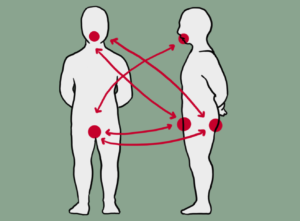Safe sex practices
In this section you will learn about healthy sex and safe sex practices.
What is safe sex?
Safe sex does not involve the loss of body fluids such as semen, vaginal fluid or blood into the vagina, anus, penis or mouth. It also means avoiding skin-to-skin contact in the genital area.
The only way to have for 100% safe sex is to:
- not to have sex (abstinence)
- for a couple to have sex only with each other throughout their sexual history
- limit sexual contact to grinding with clothes on
- have solo sex together or alone
- other forms of non-sexual touching such as cuddling or massage
How to have safer sex?
Although there is always a risk of STI’s when having sex, you can reduce the risk, if you:
- Use condom– also for oral sex
- Limit the number of sexual partners
- Practice healthy sexual communication (mutual respect and consent)
- Clean sex aids / sex toys
- Share relevant information about your sexual history and STI status with your partner
- Get tested for STIs
- If you have an STI, get treated.
Sexual hygiene:
- Wash your hands with soap before and after sex
- Clean your genitals before and after sex
- Change condoms between anal or oral sex
- Avoid oral sex immediately after anal sex
- Urinate after sex. It helps to flush out germs if you empty your bladder. Bacteria can get into your urethra during sex.
Look at the picture and read below how STIs are transmitted.
It is important to understand, that you can get a sexually transmitted infection (STI), if your partner has an infection. If you have an infection, you can transmit it to your partner when you have sex.

An infection can be transmitted when you have sex and the following body parts are in contact:
- mouth to penis / anus / vagina
- penis to penis / anus / vagina / mouth
- vagina to penis / vagina / mouth
Only condom protect against STI’s!
Look at the picture and click on the card to read more information about different types of sex.
Drag the correct word on the right picture.
